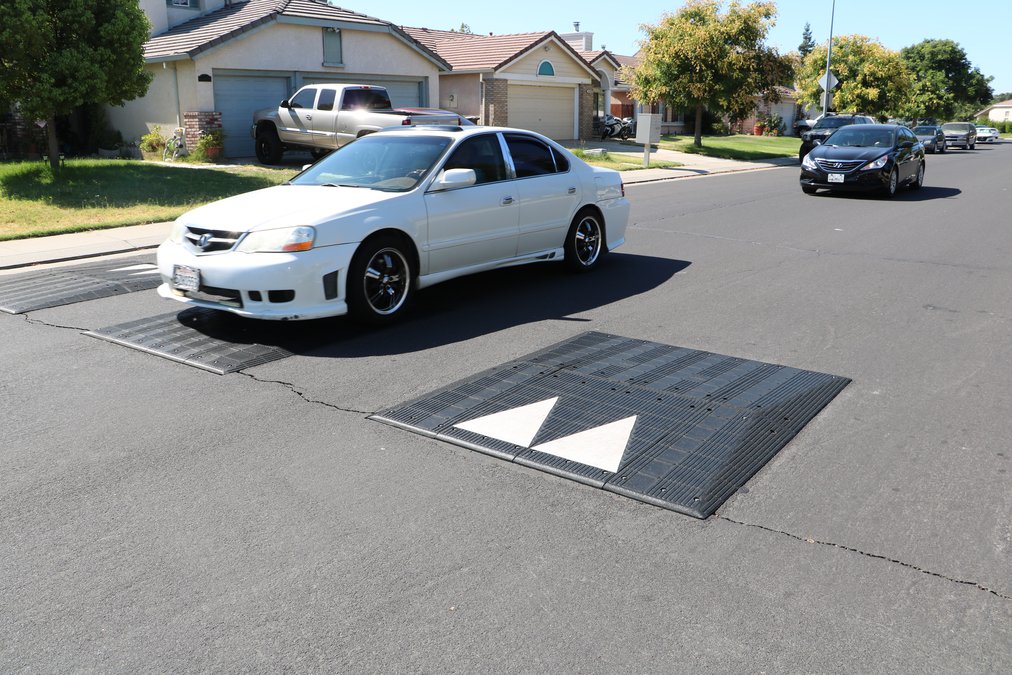Speeders could soon be taking their lumps on Hacienda Avenue.
The Manteca City Council when they meet tonight at 7 o’clock could approve the first use of traffic lumps in Manteca in a bid to calm traffic.
The speed lumps — basically four smaller speed humps spaced to allow buses and emergency vehicles to straddle them by going down the middle of the road or toward the side of the road — are planned for Hacienda Avenue between Orchard Way and La Mesa Way.
There will be pavement markings alerting motorists to the speed lumps ahead. That is in addition to signage that reads “Speed Lump” and “15 mph”.
There are no stop signs on Hacienda from the traffic signal at Louise Avenue to the four-way stop at Alameda Street. It is a distance of roughly a half mile.
While much of the traffic originates from nearby homes, as the city has added residents and more traffic it has become a shortcut of sorts to travel between Yosemite Avenue and Louise Avenue given Hacienda Avenue turns into Walnut Avenue once it crosses Alameda Street. It should be noted that Manteca Police when they do targeted traffic enforcement on streets similar to Hacienda discover a good share of speeders live nearby.
The speed lumps are expected to cost $20,000 to install.
Residents along Hacienda followed the protocols outlined in the Manteca Traffic Calming Program adopted by the council in November 2018.
It involves the following steps:
ua request for a study made by residents.
udeveloping a traffic calming plan by identifying criteria, determining hotspots, analyzing data, and identifying appropriate traffic calming measures.
uapproval process with public participation.
uimplementation and evaluation.
If the initial effort doesn’t deliver the desired results a second stage would take place. That would involve looking at applicable measures, a community meeting, and then securing department or City Council approval before implementing. That is where the Hacienda Avenue project is now.
Those involved in the approval process besides impacted neighbors are the fire department, police department, ambulance services, local and regional transit, Manteca Unified School District, public works (garbage, street sweeping, and maintenance), Community Development Department, postal carriers, and delivery services.
Key thresholds have to be met specifically for speed limits and stop signs.
One example for speed limits would be if 85 percent of the driving on a roadway that is not an arterial is traveling at speeds above 32 miles per hour then the street would be eligible for traffic calming.
Examples of thresholds that would be needed for stop signs include if an intersection has a significant number of automobile-pedestrian collisions or a high potential for them to happen, an intersection with a history of correctable traffic collisions, and a series of warrants that must be met to protect the city’s future liability.
Other examples of traffic calming measures include:
striping designed to narrow lanes and alert drivers. pedestrians and bicyclists.
bicycle lanes to promote bicycle use and safety as well as slow down vehicles by making travel lanes narrower.
Botts Dots with reflective markers to keep drivers on the right side of the road. They are especially useful on curves such as those found on North Powers Avenue.
speed limit radar displays in conjunction with static speed limit signs in a bid to educate motorists of their speed and to encourage compliance. Deployment includes temporary radar trailers and solar powered speed limit signs.
increase traffic enforcement. As opposed to other measures it would be impossible to have in place 24/7.
speed humps across the street that force motorists to slow down in order to cross. They would not be deployed on emergency response routes.
speed tables that are a flat-topped speed hump of a longer length that can be used on emergency response routes.
raised crosswalks that provide pedestrians with a sidewalk level street crossing. The raised crosswalks function as a speed hump of sorts while making pedestrians more visible to approaching motorists.
Other traffic calming devices include bulb outs, pedestrian islands, traffic circles, partial or full closure of streets, and stop signs.
To contact Dennis Wyatt, email dwyatt@mantecabulletin.com





